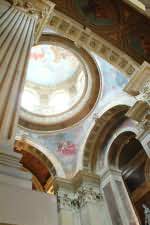Baroque architecture in England
What characterises Baroque as an architectural style? Baroque utilizes bold masses of curved shapes, strong lines, and rich colours. Above all, Baroque is sensual; decorative elements appeal almost viscerally to the senses in a way no other style can match. Yet that appeal is theatrical, intensely three-dimensional, almost grotesque in its lavish use of curves and embellishment.
Little attention is paid to proportion, indeed it could be said that the only proportion observed is one of overwhelming the viewer with exaggeration.
 |
|
Inside the Dome at Castle Howard |
Baroque architecture, though extremely popular on the European continent, had only a brief flowering in England. Perhaps this was due to an inbred inclination towards understatement by the English, or to isolation from continental ideals.
Whatever the cause, Baroque did not enjoy a long run in popular imagination in England, with a life spanning only a few decades from 1690-1730. Yet in that time the new style produced several of England's most important architectural treasures, notably Castle Howard and Blenheim Palace.
Both buildings are the work of Sir John Vanbrugh (1664-1726). Vanbrugh's designs are striking in their use of mass; his work does not rely on the embellishment or decorative touches so common in continental Baroque, but on size and scope to overawe the viewer.
The other chief practitioner of the Baroque style in England was Nicholas Hawksmoor (1661-1736) who worked with Vanbrugh for a time before making his own name as an architect, first on a succession of London churches and later on Westminster Abbey, where he was respoinsible for the western towers. The best surviving work by Hawksmoor is at All Soul's College, the Clarendon Building, and Queen's College, Oxford.
The Baroque movement produced architecture which employed classical elements in a willy-nilly free-for-all profusion. But by the third decade of the 18th century the opulent cascades of ornamental elements of Baroque gave way to the careful - and in some cases rigid - sense of proportion of the Georgian classical period.
Related:
Inigo Jones
Nicholas Hawksmoor
Examples of Baroque architecture include:
Blenheim Palace
Castle Howard
Ragley Hall
History | Prehistory | Roman Britain | Dark Ages | Medieval Britain | The Tudor Era | The Stuarts | Georgian Britain | The Victorian Age






